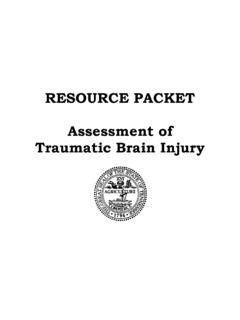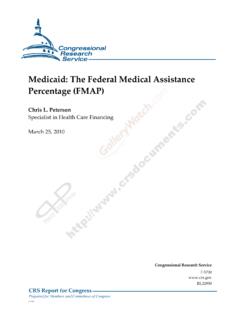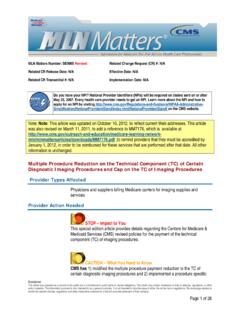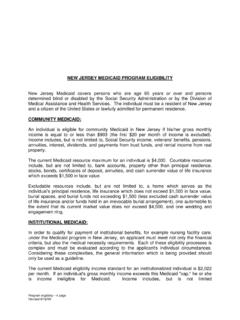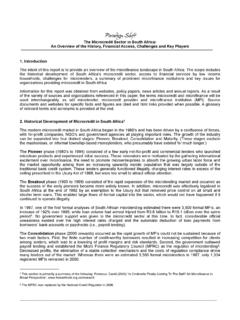Transcription of DRA.Family Opportunity Act
1 1 summary OF THE MAJOR PROVISIONS OF THE family Opportunity ACT OF 2005 (also known as the "Dylan Lee James Act") Background President George W. Bush signed the Budget deficit reduction Act (DRA) of 2005 , into law on February 8, 2006. The new law, 109-171, contains several provisions relating to long-term services and supports, including Money Follows the Person; a new option for states to provide home- and community-based services (HCBS) without using a waiver process; allow states to provide any of the services now covered under HCBS waivers; and requires states to establish stricter eligibility (level of care) criteria for institutional services than for community-based services.
2 In addition, states may continue to provide services through their existing waiver programs. The bill also reauthorizes TANF (Temporary Assistance for Needy Families), makes changes in the SSI Program, and Medicaid, as well as established the family Opportunity Act. This summary on the family Opportunity Act provision was prepared by Senate staff. PROBLEM The National Health Interview Survey (NHIS) and current census data shows that 8% of children in this country have significant disabilities, many of whom do not have access to critical health care services they need.
3 In order for these families to get needed health services for their children, many are forced to stay impoverished, become impoverished, put their children in out of home placements, or simply give up custody of their children ---- so that their child can maintain eligibility for health coverage through Medicaid. Many employer health plans and a number of CHIP/SCHIP programs do not cover essential services that these children need to maintain and prevent deterioration of their health status. Medicaid can provide these comprehensive services. In a 2003 survey of 20 states, families with special needs children report they are turning down jobs, turning down raises, turning down overtime, and are unable to save money for the future of their children and family ---- so that they can stay in the income bracket that qualifies their child for SSI and/or Medicaid.
4 Currently, less than 4% of the 850,000 children receiving social security benefits leave the Social Security rolls due to increased family income, however many would if access to needed health services was available. More than half the States in this country are reporting increasing rates of families giving up custody of their children in order to secure needed health care services and supports. The family Opportunity Act of 2005 is intended to address the two greatest barriers preventing families from staying together and staying employed 2 (1) lack of access to appropriate services, and (2) lack of access to the advocacy and assistance services they need to help cut the "red tape" to meeting their children's health care needs.
5 THE family Opportunity ACT OF 2005 Access to Health Care Coverage Expanding Medicaid Coverage Options. A new optional eligibility category will allow states to expand Medicaid coverage to children with disabilities up to age 18, who would be eligible for SSI disability benefits but for their income or resources. This option builds on previous reforms including the provision enacted in the Balanced Budget Act of 1997 (BBA) and the Ticket to Work and Work Incentives Improvement Act of 1999. These provisions permit states to offer a Medicaid buy-in for disabled children who would be eligible for SSI disability benefits but for their income, who are in families earning up to 300% of poverty ($58,500.)
6 For a family of four) In order for a family to participate in the Medicaid buy-in for their disabled child or children, a state must require a parent to take employer-offered insurance within the following guidelines: (1) the employer offers family coverage under a group health plan, and (2) the employer contributes at least 50% of the total cost of the annual premium for the coverage. If such coverage is attained by the family , the state is required to reduce the premium charged for the buy-in, in an amount that reasonably reflects the parent's premium contribution for private coverage for their child with a disability.
7 Participating states may charge premiums up to the full cost of the premium as long as that premium does not exceed 5% of family incomes up to 200% of the poverty level and 71/2% of family incomes between 200-300% of the poverty. The state may waive payment of a premium in any case where the state determines that requiring a payment would create an undue hardship. Alternatives to Psychiatric Residential Treatment Facilities for Children The bill provides funds for demonstration projects in ten States to examine the effectiveness of home- and community-based alternatives to psychiatric residential treatment facilities for medicaid enrolled children.
8 Restoration of Medicaid Eligibility Restores only the Medicaid eligibility for children meeting the "presumptive eligibility" requirements under SSI without having to wait until the "first day of the month following" the establishment of eligibility. Access to Health Information and Resources Establishing family to family Health Information Centers. The bill provides funds for establishing health information centers to assist and support families of children with disabilities and special health care needs. These centers, staffed by both parents of children with special needs and professionals, would provide technical assistance 3and accurate information to other families on various health care programs and services available and appropriate for children with special needs, including identifying successful health delivery models.
9 In addition, these centers would act as a resource to healthcare insurers, providers, and purchasers in developing ombudsman models for collaboration between families of children with special needs and health care professionals. Program Phase-In Eligible children will be phased-in over a four year period: 0-6 year olds - 2008 7-13 year olds - 2009 14-18 year olds - 2010 The CBO cost estimate for the program is $872 million /5 years.
